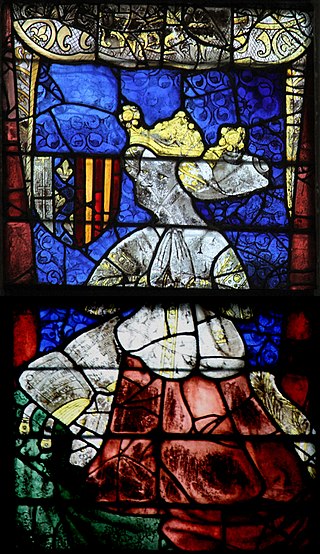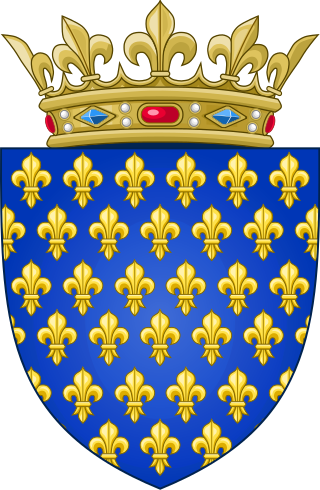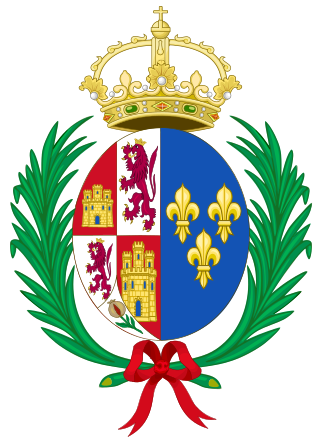Related Research Articles

Afonso V, known by the sobriquet the African, was king of Portugal from 1438 until his death in 1481, with a brief interruption in 1477. His sobriquet refers to his military conquests in Northern Africa.

Joan, Countess of Kent, known as the Fair Maid of Kent, was the mother of King Richard II of England, her son by her third husband, Edward the Black Prince, son and heir apparent of King Edward III. Although the French chronicler Jean Froissart called her "the most beautiful woman in all the realm of England, and the most loving", the appellation "Fair Maid of Kent" does not appear to be contemporary. Joan inherited the titles 4th Countess of Kent and 5th Baroness Wake of Liddell after the death of her brother John, 3rd Earl of Kent, in 1352. Joan was made a Lady of the Garter in 1378.
An heir presumptive is the person entitled to inherit a throne, peerage, or other hereditary honour, but whose position can be displaced by the birth of a person with a better claim to the position in question. This is in contrast to an heir apparent, whose claim on the position cannot be displaced in this manner.

The Duke of Brabant was the ruler of the Duchy of Brabant since 1183/1184. The title was created by the Holy Roman Emperor Frederick Barbarossa in favor of Henry I of the House of Reginar, son of Godfrey III of Leuven. The Duchy of Brabant was a feudal elevation of the existing title of landgrave of Brabant. This was an Imperial fief which was assigned to Count Henry III of Leuven shortly after the death of the preceding count of Brabant, Herman II of Lotharingia. Although the corresponding county was quite small its name was applied to the entire country under control of the dukes from the 13th century on. In 1190, after the death of Godfrey III, Henry I also became duke of Lotharingia. Formerly Lower Lotharingia, this title was now practically without territorial authority, but was borne by the later dukes of Brabant as an honorific title.

Joanna of Castile, known as la Beltraneja, was a claimant to the throne of Castile, and Queen of Portugal as the wife of King Afonso V, her uncle.

Eleanor of Austria, also called Eleanor of Castile, was born an Archduchess of Austria and Infanta of Castile from the House of Habsburg, and subsequently became Queen consort of Portugal (1518–1521) and of France (1530–1547). She also held the Duchy of Touraine (1547–1558) in dower. She is called "Leonor" in Spanish and Portuguese and "Eléonore" or "Aliénor" in French.

Henry IV of Castile, nicknamed the Impotent, was King of Castile and León and the last of the weak late-medieval kings of Castile and León. During Henry's reign, the nobles became more powerful and the nation became less centralised.

Marie of Anjou was Queen of France as the spouse of King Charles VII from 1422 to 1461. She served as regent and presided over the council of state several times during the absence of the king.

Blanche of Artois was Queen of Navarre and Countess of Champagne and Brie during her marriage to Henry I of Navarre. After his death she became regent in the name of their infant daughter, Joan I. She passed on the regency of Navarre to Philip III of France, her cousin and her daughter's prospective father-in-law, but retained the administration of Champagne. She later shared the government of Champagne with her second husband, Edmund, until her daughter reached the age of majority.

Yolande of Aragon was Duchess of Anjou and Countess of Provence by marriage, who acted as regent of Provence during the minority of her son. Yolande played a crucial role in the struggles between France and England, influencing events such as the financing of Joan of Arc's army in 1429 that helped tip the balance in favour of the French. She was also known as Yolanda de Aragón and Violant d'Aragó. Tradition holds that she commissioned the famous Rohan Hours.

The House of Plantagenet was a royal house which originated in the French County of Anjou. The name Plantagenet is used by modern historians to identify four distinct royal houses: the Angevins, who were also Counts of Anjou; the main line of the Plantagenets following the loss of Anjou; and the houses of Lancaster and York, the Plantagenets' two cadet branches. The family held the English throne from 1154, with the accession of Henry II, until 1485, when Richard III died.

The House of Capet ruled the Kingdom of France from 987 to 1328. It was the most senior line of the Capetian dynasty – itself a derivative dynasty from the Robertians.

Elisabeth of France or Isabella of Bourbon was Queen of Spain from 1621 to her death and Queen of Portugal from 1621 to 1640, as the first spouse of King Philip IV & III. She served as regent of Spain during the Catalan Revolt in 1640–42 and 1643–44.

Joan of Valois was a Countess consort of Hainaut, Holland, and Zeeland, by marriage to William I, Count of Hainaut. She acted as regent of Hainaut and Holland several times during the absence of her spouse, and she also acted as a political mediator.

Margaret of England was the tenth child and seventh daughter of King Edward I of England and his first wife, Eleanor of Castile. Her husband was John II, Duke of Brabant, whom she married in 1290, the year of her mother's death. Margaret and John had one child, John III, Duke of Brabant.

Georg Donatus, Hereditary Grand Duke of Hesse was the first child of Ernest Louis, Grand Duke of Hesse, and his second wife, Princess Eleonore of Solms-Hohensolms-Lich. He was a nephew of Empress Alexandra and Emperor Nicholas II of Russia.

The Count of Hainaut was the ruler of the county of Hainaut, a historical region in the Low Countries. In English-language historical sources, the title is often given the older spelling Hainault.

Ferdinand II was King of Aragon from 1479 until his death in 1516. As the husband of Queen Isabella I of Castile, he was also King of Castile from 1475 to 1504. He reigned jointly with Isabella over a dynastically unified Spain; together they are known as the Catholic Monarchs. Ferdinand is considered the de facto first king of Spain, and was described as such during his reign, even though, legally, Castile and Aragon remained two separate kingdoms until they were formally united by the Nueva Planta decrees issued between 1707 and 1716.
References
- ↑ Zaki, Mey (2008). Legacy of Tutankhamun: Art and History. p. 19.
- ↑ Jones, Michael K. (1993-04-22). The King's Mother: Lady Margaret Beaufort, Countess of Richmond and Derby. Cambridge University Press. ISBN 9780521447942 . Retrieved 23 November 2013.
- ↑ Ralph A. Griffiths, King and Country: England and Wales in the Fifteenth Century, (Hambledon Press, 1991), 91.
- ↑ Tunis, David L. (2005-01-01). Fast Facts on the Kings and Queens of England. Author House. pp. 125–. ISBN 9781467065238 . Retrieved 4 March 2014.
- ↑ "Saneie Masilela, 9, marries Helen Shabangu, 53 years his senior, for the second time". The Independent. 21 July 2014.
- ↑ ABC News. "Dying Wishes: Weddings to Helping Homeless". ABC News.